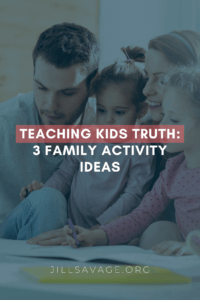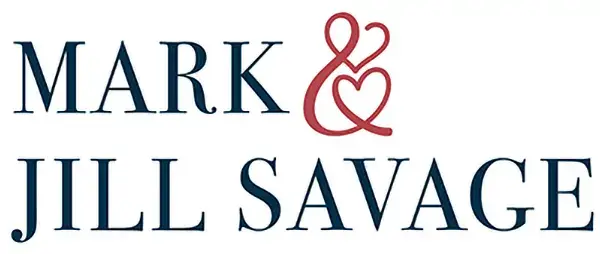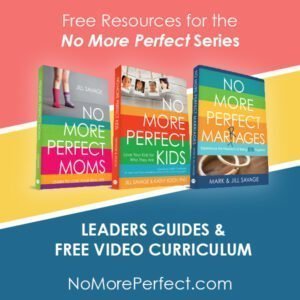 Whether you are a parent or a grandparent, it’s important to be intentional about teaching children the truths in God’s Word, to begin tucking those truths in their hearts. If you are looking for some activities to use during Spring Break, or just to incorporate into your rhythm as a family, consider the activities I’m sharing today!
Whether you are a parent or a grandparent, it’s important to be intentional about teaching children the truths in God’s Word, to begin tucking those truths in their hearts. If you are looking for some activities to use during Spring Break, or just to incorporate into your rhythm as a family, consider the activities I’m sharing today!
They actually were featured (along with four others) in my book No More Perfect Kids: Love Your Kids for Who They Are. A special thanks to Kirk Weaver of Family Time Training for originally creating these activities and letting me share them with you!
In each activity, words written in bold are when you, the parent, are speaking. Feel free to use your own words.
Most of the activities are designed for children ages 4 through 12, but they could be adapted for teenagers too!
When’s the best time for activities like these? That varies from family to family, but we suggest once a week following a meal, when the family is already together around the dinner table. It’s a logical time to share something fun with children.
If your kids are old enough to read, have them read the Bible verses shared. You might even want to have family members create their own posters or reminder cards of the memory verse after each activity. They can be created on a 3 x 5 card or on a page of computer or construction paper. Each person can decorate the card with individual style and choose where to post it to be reminded of the verse’s truth.
If you were raised in a family that didn’t do activities together to learn about the Bible, this might initially feel awkward to you. That’s perfectly normal! What I’ve learned, however, is that you’ve got to push through awkward to get to a new normal. If you want it to feel comfortable—or normal—to talk to your kids about spiritual truths, this is a great way to start!
Activity 1: Child of God
Teaching Goal: God knows us by name. He knows us personally.
Scriptures:
“See, I have written your name on the palms of my hands.” – Isaiah 49:16 NLT
“To all who did receive him, to those who believed in his name, He gave the right to become children of God.” – John 1:12
Materials:
Paper and pencils
$20 dollar bill
Blank name tag or sticky label for each participant
Scissors
A. Part 1: (All ages) Give each person a piece of paper. Let’s say that this is paper that we purchased to write on. Follow me and do what I do. Go outside, in the garage or somewhere that you can get the paper really dirty. Rub it in the dirt. Flick a few drops of water on the paper and crunch it up. Crunch the paper into a small ball in your hand. Now unfold it. Is this still good paper for writing? Would your teacher accept homework turned in on this paper? Should we use it or throw it away? Throw it away because it has lost its value as writing paper.
Take out the $20 dollar bill. Now I’m going to do the same thing with this $20 bill. Rub it in dirt, flick some water on it, crumble it up and then unfold it. Should I throw it away? No! Why not? Because it is still worth $20. We dirtied two pieces of paper, but one did not lose its value. The paper used to make a $20 dollar bill is still valuable because the U.S. government has added value to the piece of paper. The U.S. Government has said that even if it is dirty, wet, or crumpled, the bill is worth $20.
Just as the U.S. Government gives value to the $20 dollar bill, God gives value to you. Invite a volunteer to read John 1:12. When you receive Jesus—which means you trust in Christ alone for your salvation, believing that what He says is true—you become a child of God! When you are a child of God, you may still sin. Sin would be like the dirt, water, crunching and folding we did to the paper. But when God looks at you He sees past the dirty sin to the beautiful heart of Jesus at work in you. Because God created us and knows us, we have value.
B. Part 2: (Younger children) Invite a volunteer to read Isaiah 49:16. God, the creator of everything we see, knows each one of us personally! Knowing God and being known by God is what gives each one of us value. In this verse Isaiah tells us that God has my name and your name printed on the palm of His hand! How close. How personal. To help us remember this we are going to make a Palm of God sticker.
Draw a palm print on the blank label. Write on the inside: [Name] is a child of God! Using scissors, cut out the handprint. You may put this sticker on your shirt, on a book, inside a Bible, etc.
Memorize: “I have engraved you in the palms of my hands.” – Isaiah 49:16
Activity 2: Made with a Purpose
by Karen Noal
Teaching Goal: God gives us special abilities to be used for ministry.
Scriptures:
“For you created my inmost being; you knit me together in my mother’s womb.” – Psalm 139:13
“I have filled him with the Spirit of God, with wisdom, with understanding, with knowledge and with all kinds of skills.” – Exodus 31:3
A list of names of skilled workers and work needed to be done for the tent of meeting (where the Israelites were going to worship). – Exodus 31:1–11
Materials:
Paper
Pencil or marker
Peanut with shell
LEGOS, blocks, or other age-appropriate building materials
In Advance: Put the peanut in your pocket, out of sight.
A. Part 1: Even before we were born, God designed us with special abilities and skills. His plan is for us to discover those special abilities and use them for His purposes. Invite a volunteer to read Psalm 139:13. Here is an example from the Bible of people with special abilities who used them for God’s purposes:
A long time ago when Moses led the Israelites, they needed a place to worship—a church. God knew that many people would be needed and that they would need special abilities and skills to complete what He wanted done. God provided the skills and knowledge to the people he had chosen to do His work. Some people think that only preachers or teachers are important to God’s work. That’s not true. God needs people with all kinds of abilities and skills. Invite a volunteer to read Exodus 31:3.
Let’s build a building with these blocks. If we were to build a church, what kinds of materials would we need and what kind of skills would be needed to complete the building? Help children to recognize all that goes into a building and how many skilled workers are needed to make it: Architect, cement and brick layers, carpenters, plumbers, furnace and A/C installers, carpet layer, decorator etc. While children are building, tell them about everything and everyone that was needed to build the Old Testament tent of meeting. Exodus 31:1–11.
Materials: Gold, Silver, Bronze, Stones, Wood, Tents, Ark, Furniture, Clothing, Perfumes & Incense
Skills: Artistic Designers, Stone Cutters, Carpenters, Tent Makers, Craftsmen, Furniture Makers, Tailor, Scent Maker
God provides people with skills, and He wants us to use our skills and abilities to serve Him.
B. Part 2: Be sure you have the peanut in your pocket. I have something in my pocket that has never been seen or touched by anyone anywhere ever before! Would you like to guess what it is? Play this up. Get the children to wondering how it got in your pocket if no one has seen or touched it before. After a few minutes of not being able to guess, pull out the peanut. Children will at first say they’ve seen a peanut before. Crack open the peanut. You may have seen a peanut before, but this particular peanut has never ever been seen or touched by human hands. It grew inside of this shell, and this is the very first time the shell has ever been opened.
Like this ordinary peanut shell, we are ordinary people, but we have something inside of us that maybe no one has ever seen before. God has given us skills and abilities He wants to be able to use in our lives. He gives us knowledge and new skills every day. We might not be able to see the gift in ourselves or in other people, but it’s there, just like no one had ever seen the inside of this peanut.
Few skills can be learned overnight. Growing skills takes time and practice. God is building skills in you now that He will use later. We need to be ready when God wants to use our skills.
C. Part 3: Can you identify special abilities and skills you have that can be used to serve God? Let’s make a list of things you are learning to do and ways God might use your abilities later.
Examples:
Learning numbers – Help with accounting at church, Manage money better in order to give
Cook – Help with meals for special events, Cook for others, show hospitality
Memorize: “You knit me together in my mother’s womb.” – Psalm 139:13
Activity 3: Image of God
Teaching Goal: We have Godly attributes because we are made in God’s image.
Scripture: “So God created mankind in his own image, in the image of God he created him; male and female he created them.” – Genesis 1:27
Materials:
Quarter
Photograph of someone you know
Option 1: Sidewalk chalk
Option 2: Large paper and markers, bright light
A. Part 1: Invite a volunteer to read Genesis 1:27. In this very first chapter of the Bible we learn how God created the heavens, the earth, light, darkness, animals, and finally, men and women, males and females. The verse tells us that we are created in the image of God. What does the word image mean? Listen to answers. To look like. A person strikingly like another. A tangible or visible representation. What do you see on the front of this quarter? Answer or guess. This is the image of our first president, George Washington. Is it really George Washington? No. It’s just his image. What about this image is probably accurate, and what isn’t accurate? The sloping forehead, long hair, nose, and mouth are probably accurate. Silver skin, small size, flat shape are not accurate.
Show the photograph. Who is in this picture? Listen to answers. This is not the actual person. It is an image of the person. Have you ever had your picture taken and because of the angle or the lighting you didn’t think it looked very much like you? How is this picture accurate, and how is it not an accurate image? Listen to answers.
B. Part 2: Let’s make our own image! Option 1: Trace each person on the sidewalk/driveway using sidewalk chalk. Option 2: Use the bright light to create a shadow and trace each person on a large piece of paper. In the same way the drawing represents an image of us, we each represent an image of God! Inside our image let’s write down characteristics we have that are like God. (creative, loving, friendly, helpful, caring, giving, honest, hopeful, unique, compassionate, generous, loyal, etc.)
C. Part 3: We can learn more about what God is like by reading the Bible. God wants us to act and be more like Him, just like those words we put on our image.
Memorize: “So God created mankind in his own image.” – Genesis 1:27
What about you? Which activities do you plan to try as a family? Are there any other activities you have tried in the past that have worked well? Share in the comments!
*******************
Looking for more? Grab your copy of No More Perfect Kids.













All of these look amazing! I want the truth to really soak in. To start should I do these types of activities once a week?
Once a week is a good rhythm!